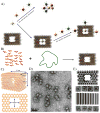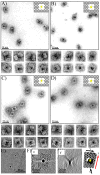Encapsulation of gold nanoparticles in a DNA origami cage
- PMID: 21344547
- PMCID: PMC3083863
- DOI: 10.1002/anie.201006818
Encapsulation of gold nanoparticles in a DNA origami cage
Figures




Similar articles
-
Suspending DNA Origami Between Four Gold Nanodots.Small. 2016 Jan 13;12(2):169-73. doi: 10.1002/smll.201501782. Epub 2015 Nov 17. Small. 2016. PMID: 26573881
-
Chemical alignment of DNA origami to block copolymer patterned arrays of 5 nm gold nanoparticles.Nano Lett. 2011 May 11;11(5):1981-7. doi: 10.1021/nl200306w. Epub 2011 Apr 7. Nano Lett. 2011. PMID: 21473607
-
Site-specific facet protection of gold nanoparticles inside a 3D DNA origami box: a tool for molecular plasmonics.Chem Commun (Camb). 2021 Mar 28;57(25):3151-3153. doi: 10.1039/d0cc07712g. Epub 2021 Feb 26. Chem Commun (Camb). 2021. PMID: 33634818
-
Precise organization of metal nanoparticles on DNA origami template.Methods. 2014 May 15;67(2):205-14. doi: 10.1016/j.ymeth.2013.10.006. Epub 2013 Oct 21. Methods. 2014. PMID: 24157708 Review.
-
Magnetic nanoparticles: design and characterization, toxicity and biocompatibility, pharmaceutical and biomedical applications.Chem Rev. 2012 Nov 14;112(11):5818-78. doi: 10.1021/cr300068p. Epub 2012 Oct 9. Chem Rev. 2012. PMID: 23043508 Review. No abstract available.
Cited by
-
Assembly of multienzyme complexes on DNA nanostructures.Nat Protoc. 2016 Nov;11(11):2243-2273. doi: 10.1038/nprot.2016.139. Epub 2016 Oct 20. Nat Protoc. 2016. PMID: 27763626
-
Engineering artificial machines from designable DNA materials for biomedical applications.Tissue Eng Part B Rev. 2015 Jun;21(3):288-97. doi: 10.1089/ten.TEB.2014.0494. Epub 2015 Feb 9. Tissue Eng Part B Rev. 2015. PMID: 25547514 Free PMC article. Review.
-
Challenges and opportunities for structural DNA nanotechnology.Nat Nanotechnol. 2011 Nov 6;6(12):763-72. doi: 10.1038/nnano.2011.187. Nat Nanotechnol. 2011. PMID: 22056726 Free PMC article. Review.
-
Expanding DNAzyme Functionality through Enzyme Cascades with Applications in Single Nucleotide Repair and Tunable DNA-Directed Assembly of Nanomaterials.Chem Sci. 2013 Jan 1;4(1):398-404. doi: 10.1039/C2SC20763J. Epub 2012 Sep 21. Chem Sci. 2013. PMID: 23264874 Free PMC article.
-
Concepts and Application of DNA Origami and DNA Self-Assembly: A Systematic Review.Appl Bionics Biomech. 2021 Nov 16;2021:9112407. doi: 10.1155/2021/9112407. eCollection 2021. Appl Bionics Biomech. 2021. PMID: 34824603 Free PMC article. Review.
References
-
- Zanchet D, Micheel CM, Parak WJ, Gerion D, Alivisatos AP. Nano Letters. 2001;1:32–35.
-
- Zanchet D, Micheel CM, Parak WJ, Gerion D, Williams SC, Alivisatos AP. J Phys Chem B. 2002;106:11758–11763. - PubMed
-
- Sperling RA, Pellegrino T, Li JK, Chang WH, Parak WJ. Adv Funct Mater. 2006;16:943–948.
-
- Huo FW, Lytton-Jean AKR, Mirkin CA. Adv Mater. 2006;18:2304–2306.
Publication types
MeSH terms
Substances
Grants and funding
LinkOut - more resources
Full Text Sources
Other Literature Sources

